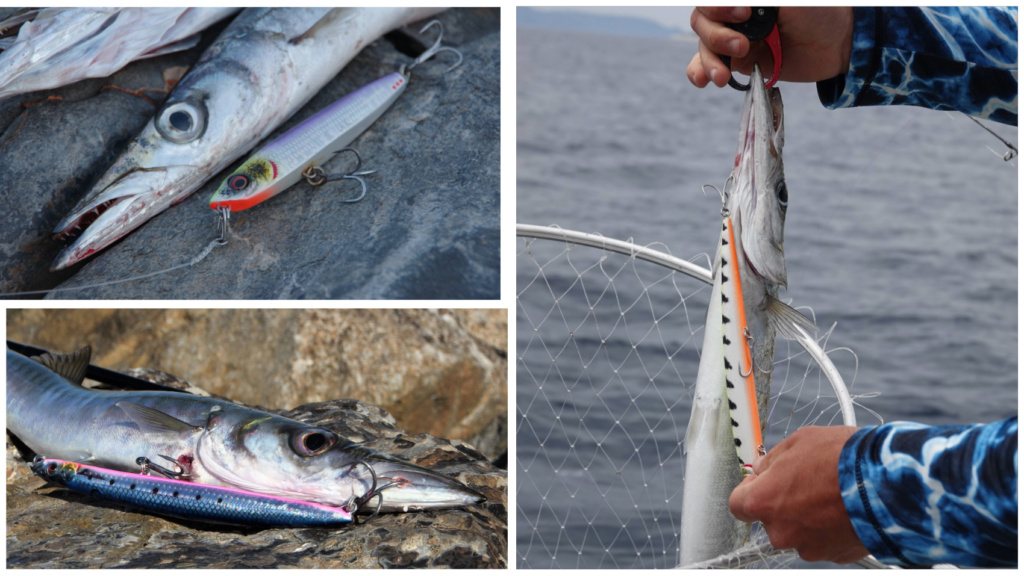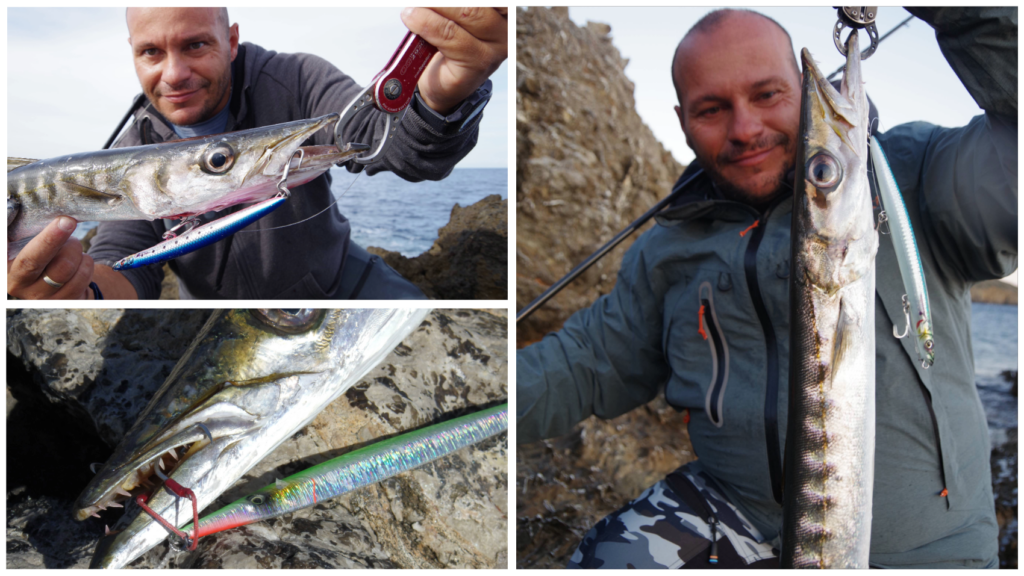Shore Jigging for Barracudas

When you stand on the rocks, the salt burns your lungs! You inhale the fresh pelagic air, preparing for the ultimate strike—a test of your patience and skills. True, we all venture onto the rocks for the big catch, but often, the “big one” proves elusive! 😅 What do we do then?

As I type these lines in mid-February, I find no better time to write this article. March marks the beginning of Barracuda spawning season in the Mediterranean at least. This reproductive period extends until the end of May, and from my experience, now is an excellent season for some fun! Two reasons support this claim: Firstly, while April-May may see the occasional Amberjack, it’s generally a poor season for rocky shore fishing. Groupers remain distant, Snappers fast before spawning, Mahi Mahi have departed, and Bonitos and False Albacores are dwindling. Barracudas, however, thrive in these conditions. They tolerate the changing temperatures that accompany the spawning season, and much of their reproductive cycle depends on the altering thermocline expected in the coming months. Secondly, targeting Barracudas is a safe bet during their spawning season. They maintain their voracious appetite, particularly the males, and even if their appetite diminishes, they fiercely protect their spawning territory, attacking anything that encroaches upon it. This territorial behavior makes them an enticing target. Concerns about fishing during their spawning season are mitigated by the fact that about 90% of the catch comprises male fish, identifiable by the white “happy juice” emanating from their lower rear fin. Gravid females are typically less aggressive, and when they do strike, it’s usually at larger soft lures or sinking pencils.

“Can I have a Barracuda on the rocks, please?”
Until now, Barracudas were incidental catches while fishing on the rocks. But now, we target them specifically. So, what do you need to know for this season? Unlike other times when you could stay in one spot and catch passing Barracudas, now you must move! You need to seek them out as they tend to stay in specific areas. Forget the deep, rapidly dropping cliffs and focus on shallower depths. This season, depths of no more than 30 meters are ideal. Personally, I concentrate between 15 to 25 meters during this time. Interestingly, rocky bottoms are less favorable now. Instead, seek out Posidonia (seagrass) beds and position your lure just above their green leaves. Barracudas lay their eggs there and complete their reproductive cycle, making mixed bottoms with rocks and Posidonia the prime location.

Lures, Jigs, and More!
So, you’re on the rocks, ready to hook some Barracudas for fun and perhaps a delicious meal. I adore grilled, souped, or steamed Barracuda on ginger and carrot slices—simply divine! But, before culinary delights, we need to catch some, right? As a general rule, male Barracudas during this time of year tend to stay near the bottom during the day and nearer the surface at night. Females rarely leave the bottom. Male Barracuda behavior can be unpredictable, alternating between aggressive strikes and passive following. When jigging, opt for a medium to slow tempo; fast jigging is less effective now. Therefore, middle-weighted jigs like the Needle Jig, Sardine Slider, and Slim Jig Minnow are excellent choices. Additionally, sinking pencils like the Cast Hacker and Deep Walker, along with larger Jerk Minnows like the Barra Jerk 210, can be highly effective as they allow for slower presentation and prolonged time in the strike zone. Regarding colors, start with natural hues. If there’s no action, switch to brightly colored jigs or hard lures. Never start with strong colors, as fish will understand soon the catch behind them. You will get a strike or two for sure, but the dream will end soon. What I do is, when I find the pack of the barracudas, (always with natural colored jigs and lures) I try to get as many as I can. Once they stop responding to natural colors, then I use strong colors, and this often yields more bites. Once the Barracudas become unresponsive to strong colors, it’s time to move on to find a different pack. Here’s a video link on strong colors that you might find useful: https://youtu.be/2vJi1o4u5lQ. Revisiting an area later in the day often yields additional catches. Fortunately, Barracudas, just like Saddled Breams, form small “gangs” during this season, fiercely guarding their territory. This behavior allows for the possibility of encountering multiple packs in close proximity if you’re willing to search diligently. Note that fishing at night is possible, especially with hard lures, but it’s tricky and potentially hazardous. If attempting nighttime fishing on the rocks, ensure it’s in a safe location with your car nearby and a strong mobile phone signal.
Super Sharp Hooks!
I know this might seem self-explanatory, and unnecessary to mention but I feel the need to emphasize once again the necessity of using super sharp treble and assist hooks. Especially now, when Barracudas are prone to attack for territorial reasons, they often strike with their mouths closed. Consequently, you’ll only feel the strike without a hook setting if your hooks aren’t PERFECTLY sharp! Having super sharp treble hooks on the hard lures and assist hooks on the jigs is ALWAYS mandatory, but especially crucial during this time. Double Assymetric Bloody Assist Assist hooks on the jigs is the way to go now! If you have doubts about your rigging on your jigs, here is a link that explains enything you need to know, so you wont miss a fish. https://youtu.be/wo5RErBkb4k

Barracudas may not be the strongest fish due to their shape, but their fearsome appearance and insatiable appetite have earned them a formidable reputation among anglers. Unfortunately, many anglers believe Barracudas can only be caught at night in ports, while some claim they don’t strike during the day in certain countries. However, I’ve caught Barracudas during the daytime on rocky shores in Turkey, Cyprus, Spain, and Albania. Their behavior remains consistent across these locations, at least in the Mediterranean, for those bold enough to search for them diligently. Remember, the natural hunting ground of Barracudas isn’t the port; it’s where few anglers dare to venture, investing time and effort in the pursuit.










